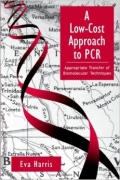Generic Lab Equipment
Let's make an overview and show some historic examples...
Contents
Historic Books
Various from the resources of Arvind Gupta
See loads of good stuff on Arvind Gupta's Website
Low Cost Equipment for Science and Technology Eduction,
COMPILED BY UNESCO Make school science equipment using inexpensive materials.
- LOW COST EQUIPMENT FOR SCIENCE AND TECHNOLOGY EDUCATION - Vol. 1
- LOW COST EQUIPMENT FOR SCIENCE AND TECHNOLOGY EDUCATION - Vol. 2
New UNESCO Sourcebook for Science Teaching, 1973
Do It Yourself Lab Equipment
A Low-Cost Approach to PCR, Eva Harris, 1998
The polymerase chain reaction (PCR) is a technique used to replicate specific pieces of DNA millions of times, which permits the detection and analysis of minute amounts of nucleic acids. Since its introduction in the late 1980s, this technique has been applied not only in molecular biology research but also in fields as diverse as anthropology, phylogeny, and forensics. However, despite the large impact of PCR, many of its applications remain within the confines of research and the academic environment. Now, in A Low-Cost Approach to PCR: Appropriate Transfer of Biomolecular Techniques, Dr. Eva Harris makes this elegantly simple technique more accessible to researchers, physicians, and laboratory workers throughout the world. She provides a description of the theoretical basis of the technique, the practical details of the method, and the philosophy behind the technology transfer program that she developed over the last ten years.
Download File:Low cost approach to PCR - 2007.pdf
Build-It-Yourself Science Laboratory, Raymond E. Barrett, 1963
Raymond E. Barrett's Build-It-Yourself Science Laboratory took on an audacious task: to show readers how to build a complete working science lab (starting with a workbench) for chemistry, biology, and physics--and how to perform experiments with those tools. The experiments in this book may appear fearless and bold by today's standards, but many from previous generations fondly remember how we as a society used to approach scientific learning. Updated for today's world with annotations and sourcing notes by Windell Oskay of Evil Mad Scientist Laboratories, prepare to read (and use) this classic to reinvigorate scientific exploration at school and at home.
Links to other pages
Appropedia - Building research equipment with free, open-source hardware
Most experimental research projects are executed with a combination of purchased hardware equipment, which may be modified in the laboratory and custom single-built equipment fabricated inhouse. However, the computer software that helps design and execute experiments and analyze data has an additional source: It can also be free and open-source software (FOSS). FOSS has the advantage that the code is openly available for modification and is also often free of charge. In the past, customizing software has been much easier than custom-building equipment, which often can be quite costly because fabrication requires the skills of machinists, glassblowers, technicians, or outside suppliers. However, the open-source paradigm is now enabling creation of open-source scientific hardware by combining 3D printing with open-source microcontrollersW running on FOSS. These developments are illustrated below by several examples of equipment fabrication that can better meet particular specifications at substantially lower overall costs.
Citizen of Science
With the use of recycled and second-hand items I hope that individuals and teachers will use this blog to bring back the joys of doing science. Warning - I am not responsible for any damage or injuries obtained while using any information from this blog. This is for information purposes only.
